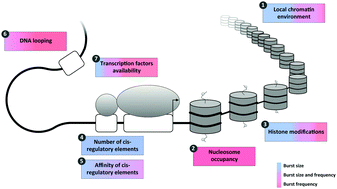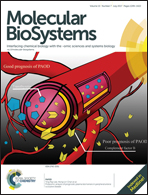What shapes eukaryotic transcriptional bursting?
Abstract
Isogenic cells in a common environment present a large degree of heterogeneity in gene expression. Part of this variability is attributed to transcriptional bursting: the stochastic activation and inactivation of promoters that leads to the discontinuous production of mRNA. The diversity in bursting patterns displayed by different genes suggests the existence of a connection between bursting and gene regulation. Experimental strategies such as single-molecule RNA FISH, MS2-GFP or short-lived protein reporters allow the quantification of transcriptional bursting and the comparison of bursting kinetics between conditions, allowing therefore the identification of molecular mechanisms modulating transcriptional bursting. In this review we recapitulate the impact on transcriptional bursting of different molecular aspects of transcription such as the chromatin environment, nucleosome occupancy, histone modifications, the number and affinity of regulatory elements, DNA looping and transcription factor availability. More specifically, we examine their role in tuning the burst size or the burst frequency. While some molecular mechanisms involved in transcription such as histone marks can affect every aspect of bursting, others predominantly influence the burst size (e.g. the number and affinity of cis-regulatory elements) or frequency (e.g. transcription factor availability).



 Please wait while we load your content...
Please wait while we load your content...